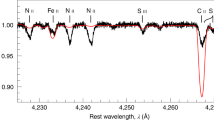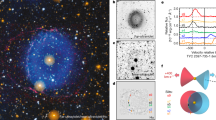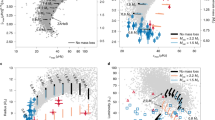Abstract
Cameron1 and Stothers2 have suggested that the companion to ε Aurigae is a collapsed star. Epsilon Aurigae is one of several binary stars with large mass functions and invisible secondaries and so far the primaries of two of the brightest of these, ν Sgr (ref. 3) and β Lyrae, have been found to have helium-rich atmospheres. This shows that mass exchange has occurred, and that the visible star has been stripped down to its hydrogen deficient core by transferring matter into the vicinity of the former secondary. This explanation for ε Aur is the third of four possibilities discussed by Stothers. The proof of it would be the discovery of anomalously strong He I lines, such as λ5876, which appear in cool helium rich stars like R Cr B (ref. 4). This spectrpscopic check should be made.
This is a preview of subscription content, access via your institution
Access options
Subscribe to this journal
Receive 51 print issues and online access
$199.00 per year
only $3.90 per issue
Buy this article
- Purchase on SpringerLink
- Instant access to full article PDF
Prices may be subject to local taxes which are calculated during checkout
Similar content being viewed by others
References
Cameron, A. G. W., Nature, 229, 178 (1971).
Stothers, R., Nature, 229, 180 (1971).
Hack, M., Abundance Determination in Stellar Spectra (edit. by Hubenet, H.), 227 (Academic Press, London, 1966).
Danziger, I. J., Mon. Not. Roy. Astron. Soc., 199 (1965).
Huang, S. S., Astrophys. J., 138, 342 (1963).
Woolf, N. J., Astrophys. J., 141, 155 (1965).
Gehrz, R. D., and Woolf, N. J., Astrophys. J. (in the press).
Low, F. J., and Mitchell, R. O., Astrophys. J., 141, 327 (1965).
Author information
Authors and Affiliations
Rights and permissions
About this article
Cite this article
WOOLF, N. Collapsed or Neutron Star Companions of Bright Stars. Nature 230, 39 (1971). https://doi.org/10.1038/230039a0
Received:
Issue date:
DOI: https://doi.org/10.1038/230039a0
This article is cited by
-
Black Holes and Gravitational Theory
Nature (1972)
-
Physical Sciences: Nature of the Secondary Component of Beta Lyrae
Nature (1972)
-
Gravitational collapse and related phenomena from an empirical point of view, or, Black holes are where you find them
General Relativity and Gravitation (1972)



